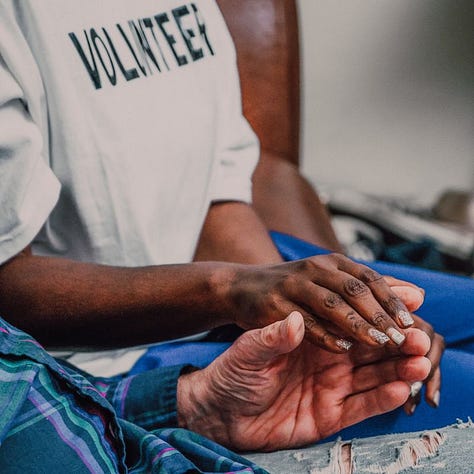GENEROSITY: the uplifting art of giving
Gratitude practices allow us to appreciate ourselves in a receiving mode, a similar warm glow awaits when we cultivate our giving mode, and maybe this is more important than ever.
It’s common knowledge that gratitude is more than a life-style trend, its practices offer measurable positive effects on the body-mind. A recent meta-analysis of more than 60 research trials conducted since the early 2000s concluded that overall, those who participated in gratitude interventions experienced: “better mental health, and fewer symptoms of anxiety and depression. Moreover, they experienced other benefits such as a more positive mood and emotions.” 1
This isn’t surprising when we remember that the practice of gratitude releases neurotransmitters and hormones associated with feelings of contentment and reinforces the bonds we have with friends, family, work and social communities. It can even enhance our connection to the natural world, when we are grateful for the sight of a sunrise after days of cloud cover, a sudden glimpse of the moon between roof tops, or an unexpected hare racing across a bare, winter field. As the Benedictine monk, Br. David Steindl-Rast the “grandfather of gratitude”, is often quoted: “It’s not happiness that makes you grateful, it’s gratefulness that makes you happy.”
Generosity, when an act of selflessness, has equally measurable physiological and psychological effects mediated through our neuroendocrine system. This means that we experience a similar “warm glow” of happiness coupled with an all-round improvement in our mood, a greater sense of connection with others, and an increased sense of altruistic purpose.



HOW GENEROSITY PLAYS OUT IN THE BODY
In our nervous system, at the autonomic or involuntary level, acts of selfless generosity are more able to arise when we are in parasympathetic states of being, that is to say, when we are feeling safe, at ease, and calm. This is when we might find ourselves functioning within the concept of the “social engagement system”.2 From this ground state, acts of giving or altruism activate the reward centres in our brain resulting in a dopamine surge that creates a feeling of pleasure, which in turn reinforces our positive behaviour. At the same time, a flood of serotonin circulates further improving our mood and we experience a decrease in the production of stress-related chemicals, adrenaline and norepinephrine. Where our acts of generosity directly affect our social bonds there will be a rise in oxytocin, the ‘love hormone’, and a reduction in cortisol levels stimulating more feel-good chemicals in the form of endorphins.
This chemical mixture leads to a short term experience soemtimes called the “helper’s high”3. However, when we make a habit of conscious acts of generosity, it’s been shown to have longer term effects including sustained lower blood pressure, increased immunity and even extended longevity4.
In short, the neuroendocrine landscape of generosity is very similar to that of gratitude yet, at another level it seems to balances the books ensuring that we cultivate both our giving and receiving modes of being.



DIFFERENT KINDS OF GENEROSITY
It’s worth noting that generosity can fall into two camps: the selfless kind and the self-motivated kind. Both involve acts of giving however, they differ primarily in their intentions and outcomes including our body’s neuroendocrine responses.
Acts of selfless generosity are rooted in a genuine impulse to offer benefit to others and are performed without any need or expectation for recognition, reward, or personal gain. Rather, the giver is motivated by compassion, empathy, and perhaps a sense of moral duty and remains undisturbed and non-attached to any particular outcome. The recipient as a result is likely to find themselves awash in a sea of postive gratitude chemicals.
Examples of selfless generosity include volunteering for a charity or cause, making donations without virtue signalling, and everyday gestures like buying a little extra at the supermarket for food-bank collection, holding the cafe door open for the mum navigating the streets with a push chair, taking out the bins for a less-able neighbour, or bringing them in for the one who has a long and late commute from work.
Self-motivated generosity, on the other hand, is rooted in transactional thinking, and it muddies the concept of altruism with self-interest. These acts of giving arise when the giver seeks a personal benefit for example, a reciprocal favour from the recipient of the gesture (you scratch my back, I’ll scratch yours), or an increase in social or professional status. We might also be looking for some kind of emotional exchange perhaps a relief from a sense of guilt or entitlement, or a craving for the feeling of being thanked and appreciated. Generally speaking, this kind of helper’s high offers only temporary and precarious satisfaction for the desired exchange may not materialise and any initial mood boost can lead to conflicting feelings of frustration and disappointment. As for the recipient, any sense of gratitude may be tainted with ideas of suspicion, manipulation or obligation.
THE SCARCITY MINDSET
It’s a good moment to mention this. This is the bodymind state where we find ourselves permeated by the feelings of real or perceived deficiencies, such as a lack of time, money, or emotional reserves. If we become fixated on lack, it can not only affect our willingness or ability to make selfless acts of generosity, but research has also shown it clouds our mental clarity more generally. The perception of scarcity narrows our focus to one of self-preservation making us cling to our resources or hesitant to share them. It reduces any bandwith we might otherwise have for considering the needs of others or valuing any potential long-term benefits from our generosity.
The scarcity mindset, unsurprisingly, arises from the ground of our sympathetic neuroendocrine system, one where we are responding to a real or imagined threat to our well-being. When we recognise this we might be able to evaluate and address our sense of "not enough", and regulate ourselves towards the more expanisve states of parasympathetic gratitude and generosity.
SPIRITUAL GENEROSITY
To wind things up, I wanted to address this idea first with reference to the French philosopher, mystic and political activist, Simone Weil (1909-1943) who wrote that ”Attention is the rarest and purest form of generosity”.5 This phrase encapsulates her belief that clear attention, whether directed toward a person, an idea, or a task, is a profound act of selflessness. Indeed, she likened attention to the highest form of prayer, in that to fully attend to something we must set aside our self-centered way of experiencing the world and create space for non-judgemental receptivity and connection.
You might recognise this perspective through the work of your favourte poets. In many of Mary Oliver’s poems, for example, her words invite us into moments where her own attention has been accutely arrested whether it is with the grasshopper (The Summer Day), the heron (Poem of the One World), or the bear (Spring). She also makes very clear in the poem, Praying, that the object of our attention is irrelevant to the fruits, or the poetry, that may arise through the exchange of generosity and gratitude.
It doesn't have to be
the blue iris, it could be
weeds in a vacant lot, or a few
small stones; just
pay attention, then patcha few words together and don't try
to make them elaborate, this isn't
a contest but the doorwayinto thanks, and a silence in which
another voice may speak.
I’m looking forward to sharing more about generosity in the Companion Notes. There will be a number of journaling prompts for reflecting on the theme. I’d also like to expand a little on the yogic principles of asteya and aparigraha which seem to fall into the spirit of generosity.
Until then, sending you warmest wishes,
Beverley
PS: Thanks so much for subscribing to Field Notes From The Body, I really do appreciate you showing an interest in my writing and for “liking”, “commenting”, and “recommending it to others. Please note the CHAT on the app is open to all at the moment. Do drop by and say hi!





